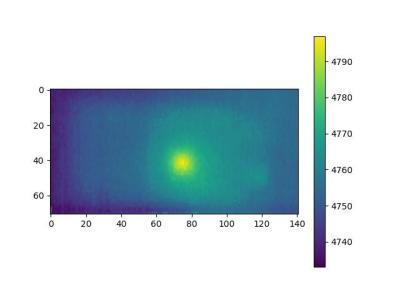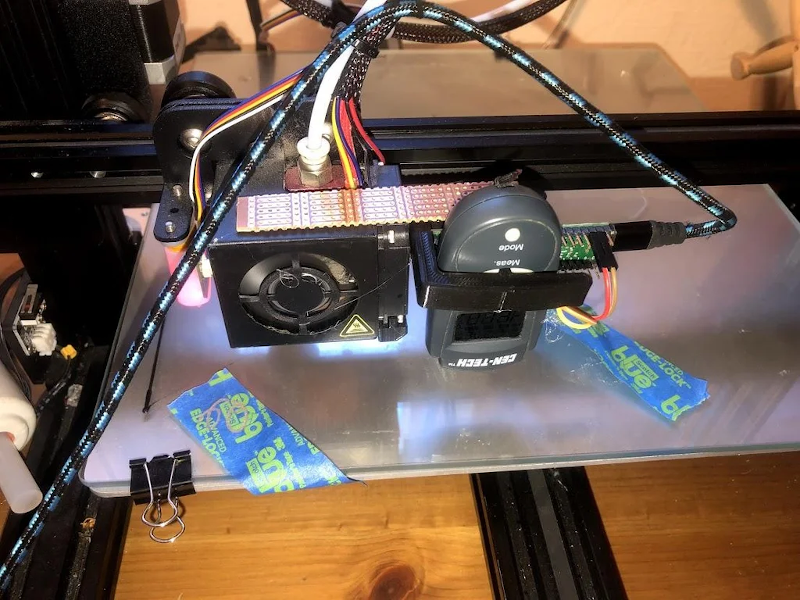Don’t blame us for the title. [CCrome] admits it may well be the cheapest and worst IR camera available. The concept is surprisingly simple. Mount a cheap Harbor Freight non-contact thermometer on a 3D printer carriage and use it to scan the target. The design files are available on GitHub.

There is, of course, an Arduino to grab the data and send it to the PC. Some Python code takes care of converting it into an image.
Perhaps you don’t need a camera, but having a way to communicate with an $11 IR temperature sensor might come in handy someday. You do have to mash the measurement button down, so [CCrome] used the 3D printer to make a clamp for the button that also holds the POGO pins to the PCB. We would have been tempted to solder across the switch and also solder the wires to the pad. But, then again, you need a 3D printer for the project anyway.
Don’t expect the results you would get from a real thermal sensor. If you want that, you may have to build it yourself or open your wallet wide. If you need some inspiration for a use case, look at the thermal camera contest from a few years back.















Neat idea!
I’ve always wondered if one could build a workable thermal imaging device by constructing an array of these sensors
In the early days of the WWW, like 1995-6, there was a long-since vanished website where the guy had both an IR thermometer and a photodiode hooked up to an xy pan/tilt setup that slowly scanned his room, so you got a weird hazy picture with ghostlike streaks across it as he moved around the room. He also had a running histogram of the amount of visible and IR light present in the room, essentially a running integration of the last several scans. I think it was called the one-pixel webcam project. I was completely smitten with it at the time.
I hadn’t come across the site back in the day, but there are a few people still doing something similar, and I think I found the one you were talking about, using Archive.org.
https://web.archive.org/web/20060223103427/www-jcsu.jesus.cam.ac.uk/~rpc25/webcam2/
If you had an LCD-ish thing which could be selectively transparent to IR you could probably use this to implement one of those lensless camera things (the screen goes in front of the sensor, you turn on a random set of pixels and record the light, then solve the resulting giant set of linear equations to obtain values for each pixel).
I wonder if the LCD shutters on Adafruit meet the “selectively ir transparent” criteria
The glass in LCDs is opaque, reflective, and emissive at thermal IR wavelengths: you can’t see through it. Besides, the polarizers are transparent, si twouldn’t work anyway, even if the liquid crystals would work at those wavelengths (and they probably won’t). Three strikes make a triple ‘nope’.
However, you could use a Nipkow disk, or a more efficient modern equivalent like scanning a Costas or Hadamard array binary mask in front of the detector. Instead of a disk, use a rotating cylinder: picture the detector looking out the side of a perforated tin can as it rotates around it.
This approach works great for X ray and gamma ray imaging (the holely rotating cylinder being lead or tungsten), and similar approaches have been shown here on HaD for optical imaging. If you’ve got decent linearity and SNR in the thermal detector it will work there too.
Very cool! Especially since measuring temperature over a printers heated bed is a useful thing to have. Now that you know your heat pattern of the bed, I wonder what can be done to improve it’s uniformity, besides just replacing it outright.
I find it always nice to see DIY IR camera hacks! For those who are interested in the topic, I’ll also drop the article about my IR thermometer camera hack here: https://hackaday.com/2017/01/19/diy-thermal-imaging-done-low-tech-style/
Web cam OCR!
Indeed :)
Cool! It’s not immediately obvious to me what software you’re using to interpret the digits. What is that? I wonder if there are any test points on those grip type thermometers.
You can find the program here: https://github.com/royrobotiks/DIY_thermal_imaging
Tractor Supply has a gun-type IR theremometer for $12 now with a 12:1 measurement cone. Good wide temperature range also… I know there are still some of you that like the brick-and-mortar.
45 years ago I was involved with a product called a “Probe Eye Infrared Camera” sold mostly for firefighting, plant inspection, etc. If memory serves it had single (maybe a few?) infrared receptor (cooled by a tiny nitrogen bottle) that was sitting next to a rotating mirror, where each segment of the mirror was tilted up from the previous mirror. As the mirror spun, it produced a maybe 30×20 “video”. Cool idea at the time. I see them on eBay every once in a while.
It costs a bit more than $11, but here’s a project that uses a 32 x 24 sensor and a bunch of adafruit/sparkfun parts: https://hackaday.io/project/181230-simple-thermal-camera